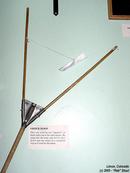In the old RR videos and photos you often see towermen lifting up paperwork on a pole to train crews. These were "train orders". Can anyone tell me what they were exactly and why today there are no more ground crews hoisting them up to train crews on poles?
carajul wrote:In the old RR videos and photos you often see towermen lifting up paperwork on a pole to train crews. These were "train orders". Can anyone tell me what they were exactly and why today there are no more ground crews hoisting them up to train crews on poles?Train orders can be anything from giving a crew permission to operate on sections of track to giving a stop and protect order for malfunctioning crossing protection. Train orders, aka track warrants are still given out on a daily basis. The reason you no longer see train orders get "hooped up" or hung on poles is because they are now transitted by radio or given via landline or cellular telephone.
